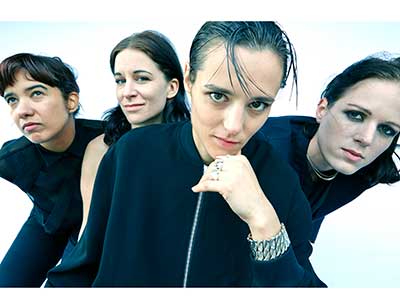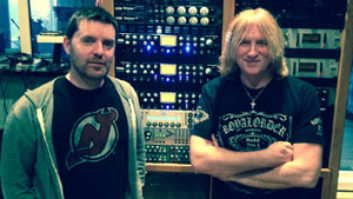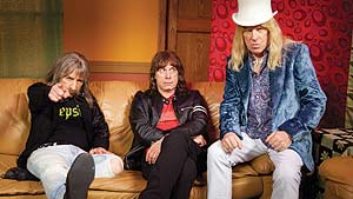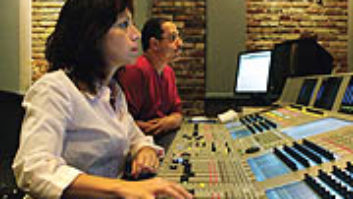
There is a moment during a band’s live show where they announce they’re going to play a new song. This is met with an enthusiastic reaction from the audience, but in all honesty, the crowd just wants to hear the favorites. For the band, however, this is an opportunity to try out new material and get instant feedback. For the UK-based/French-fronted foursome Savages, trying out of new songs and getting instant feedback is taken to the extreme.
The post-punk quartet released its raw debut, Silence Yourself, to an avalanche of fan and critic approval in 2013. A year prior to the release of its follow-up, Adore Life, the group flew to New York for a month to play nine gigs, three per week, in three different venues. The sole purpose for this was to test out the songs written for Adore Life in a live setting and gauging audience response.
“They are really brave,” says Johnny Hostile, producer of both Savages albums, longtime partner of Savages vocalist Jehnny Beth, and considered the unofficial fifth member of the group. ”The first album was created for a live stage purpose. When they started to write the second album, they didn’t tour at all. They didn’t experience it live so they missed that aggression at a very early stage; the adrenaline element wasn’t there. This was a creative way to bring what they needed. They are really confident about what they do, what to aim for, and what they want. I was there to make sure they don’t have an identity crisis.”
Once the savage ingredient was in place, the group and Hostile set up at London’s RAK Studios with engineer Richard Woodcraft. On Silence Yourself, Hostile recorded the band all together, in the most punk way they could manage, with only a few retakes, resulting in a tough-sounding record. For Adore Life, Hostile wanted to make sure he did just the opposite. To this end, he spent a significant time in preproduction with individual members, delineating each part of their instrument’s tone, texture and tempo. The Savages themselves are as detail-oriented as Hostile, with guitarist Gemma Thompson spending over a week on experimentation or drummer Fay Milton spending an entire day picking out cymbals.
The drums are a particular standout on Adore Life, something Hostile had in mind as it was one area he was not entirely satisfied with on Silence Yourself. Milton spent 10 days on drums with Hostile and Woodcraft in RAK’s Studio 3, whose Neve VRP Legend 60-channel console with Flying Faders automation was the perfect setting for her combination Yamaha kit and RAK’s 1969 Ludwig Hollywood. The kick is miked with an AKG D12 VR and Neumann U 47 FET to separate tracks. Shure SM57 on the top and bottom snare with Sennheiser MD421 on the toms and a pair of Coles 4038s overhead for control to the top of the kits with Savages’ cymbal-heavy sound.

“The Neve is really well-maintained and sounds good for anything,” Woodcraft says. “It is the live room that is more beneficial for the drum sound. It has a really nice controlled percussive brightness that can be left natural or made more aggressive. The mic pre’s are quite neutral-sounding, though, which is why I used outboard combinations for the key elements of the kit. I committed to recording with a considerable amount of processing in preference to using any plug-in effects in the box. For example, APIs for kick and snares, AMS Neve 1081s for overheads with EQ, AMS Neve 1073DPDs for the M50s used as the main stereo room microphones.”
Hostile and Woodcraft moved to RAK’s Studio 2 to record guitars, as that room is more intimate, which is what Hostile wanted, and has an API desk from 1976 and a wider selection of outboard gear. The guitars are amped with a modern Fender Twin and an early ’60s Vox AC30 running parallel with a classic 57/421 combination on each amp going into the API.
“The vintage API makes for great guitar recordings: fast, punchy, clear preamps and 550A EQs for adding a bit of extra tone after the amp,” Woodcraft says. “There’s also a nice thing you can do with some auxiliaries that add cool overtones. Careful placement and use of room mics helped add to the atmosphere and parts.”
He continues, “For the bass, we often swapped between heads for different songs as the sound and what we wanted it to achieve in the track would vary. It was quite a complicated setup with a carefully considered balance of different mics between tracks. For a few songs, I used my early ’60s valve Watkins Copicat as a preamp with tape compression, sometimes with a tiny amount of slapback. There could also be one or two of [bassist Ayse Hassan’s] pedals in-line depending on song or sections of verse or chorus.”

During the first week of recording, the only time the group performed together, for the purposes of laying down guide tracks, Beth used a Shure SM7B through a Calrec RPQ 3200 channel strip and UREI 1176 Silver Face. This microphone was used mainly as a way to keep spill down during these takes, but it also lends itself well to a busy track, has the effect of compressing itself, and is less intimidating to vocalists.
“When you have a strong vocal, it’s hard to convince singers to push hard,” Hostile says. “You can shout into the SM7B. It’s like a live microphone, and vocalists feel very comfortable to play around, scream, all that stuff.“
The details carried through to the recording platform, which at RAK is Pro Tools, then editing on Logic at Hostile’s producer studio in Paris, and finally mixed by Anders Trentemøller on Ableton Live.
“I premix everything,” Hostile says. “I make sure all the effects, the space, the groove, the energy is there, that I’ve got the album aesthetically before it goes to mixing. I wanted [Trentemøller’s] genius on this project. I went on tour with him and fell in love with his music. When I asked him to mix the record, he said he was a massive fan of Savages but had never mixed a rock record, or anyone else’s music besides his own.
“He’s good at re-creating space, he’s very subtle, he loves low end, and that’s what I was aiming for on this album. His sound is so precise and his dynamic is so impressive that I thought if we only could have a bit of that on the record, we could do something really special.”



